Peter has brought Christmas Cheer to our home with elegence. The live greens are lush and full, the lights a perfect hue, the bows festive accents, and the planning thoughtful and tailored to our family. He is wonderful to work with, and I can't wait to do so again.Read More
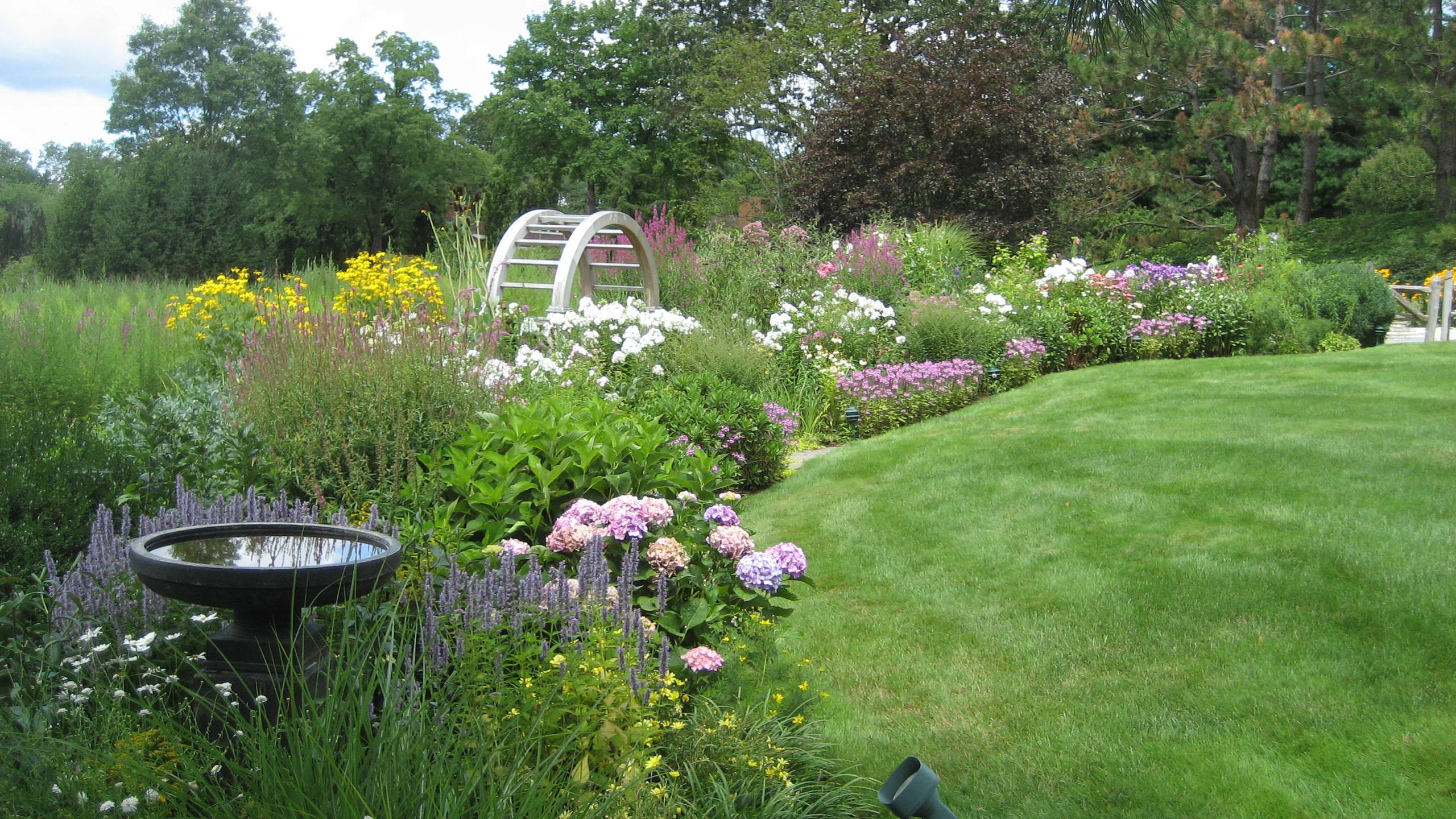

PETER ATKINS AND ASSOCIATES.,LLC
"Artisans in the Garden"
P.O. Box 238 - Bedford Village, NY 10506
(914) 234-0161
PeterAtkinsandAssociates@gmail.com
Licensed and Insured
Current Home Improvement License
Introduction to Perennial Gardens
Peter Atkins and Associates would be honored to reconstruct an existing garden or create a new garden that seamlessly meld the land to the surrounding architecture and enforce the strengths of the broader environment. No matter how formal or rustic, these gardens are meticulously designed to exude a sense of ease and beauty so that it seems they have always existed uses native perennials whenever possible.
While our highly skilled team of craftsmen take personal pride in the installation of each project, we also enjoy collaborating with other design professionals — architects and interior designers — to ensure that our client’s dream is fully realized.
A landscape without perennial gardens is a one-season event. After the spring display of flowering shrubs is over, perennials take center stage. Sure, there are some late-flowering shrubs in summer like Spirea, Hydrangea and shrub roses but for the most part, the spectacular summer color belongs to perennial flowers. Especially here on the New England territory. The importance of a good perennial flower design cannot be overstated.
The best piece of advice I can give when designing your new garden is to start small. The best way to display your perennials is in plant clumps of at least three to five plants of your favorite, most coveted species. Growing perennials together is the most practical option it allows for easy planting, soil preparation, and care.
Living architecture. Perennial garden design is not as simple as picking out some plants at your local garden center. A good perennial design must take into account color combinations, blooming times, and plant heights. There are some perennials that only bloom for several weeks; others will bloom all summer. Some perennials stay where they are – others, like Bee Balm and Black-Eyed Susans, will re-seed until they take over the flower bed. Most perennials will thrive in full sun; but only a few will survive in shade.
To create a manageable sweep, plan one that is between five and eight feet deep and twenty feet long. To define the boundaries of your garden, boxwoods or other evergreens anchor the ends and provide great edge definition. Taller-growing plants should be positioned in the back, or even at the center of an island bed, with the lower-growing plants centered in front or around the larger ones.
Mix it up. Even with a well thought out perennial plan, any garden needs balance. A conifer backdrop, a red foliage ornamental tree or sedge grasses can add a lot of depth to a perennial garden. There may also be – despite our best intentions – gaps in the blooming cycle. In this case, it’s not a bad idea to incorporate a few annual flowers in key spots. Whether border annuals like Marigolds and Snapdragons, or tall background flowers like cleome, annual flowers can provide constant color until the first frost.
Color blending your garden works well if you follow the color wheel and place complementary colors next to each other. For example, a splash of yellow is a stunning addition to a garden filled with reds and lavenders. Lighter flowers really make nearby dark flowers pop. When you choose perennials, look for full and colorful foliage with new growth appearing.
A common misunderstanding about perennials is that they are maintenance free. While it’s true, you plant them one time and they come back every year – they do require a certain degree of maintenance. As they grow, perennials will crowd each other out. Every few years, they will need to be divided and moved out of the flower bed. One of the great benefits of having perennial gardens in your yard is that you will have a never-ending supply of plants – and thus, a never ending supply of plant-loving friends to share them with!
The magic of Lupins blooms nonstop in a clients meadow planted by Peter Atkins
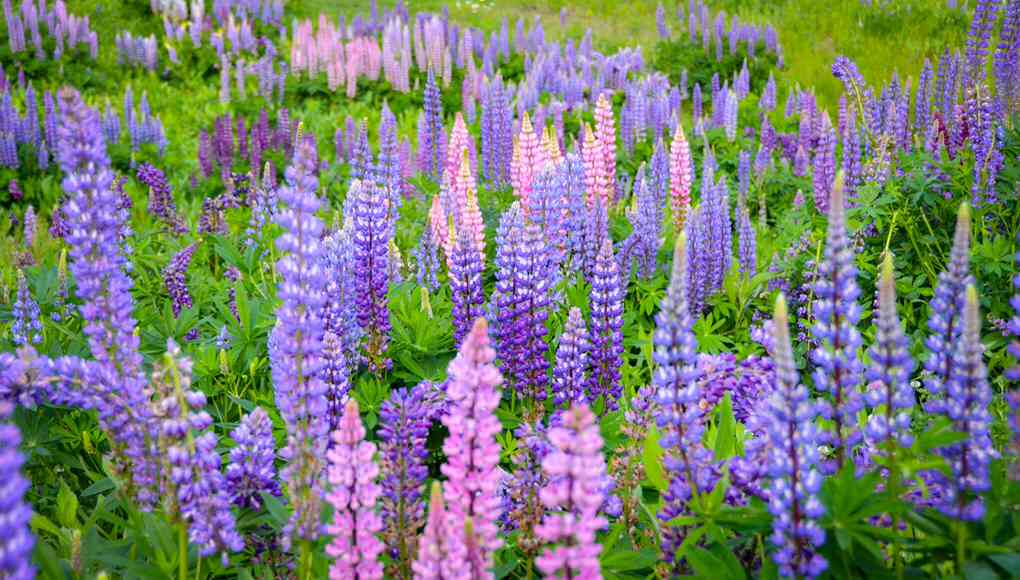
Pollinator Perennial Gardens on the same property in two different compositions
Pink Muhly Grass with Pampas Grass with white Plums
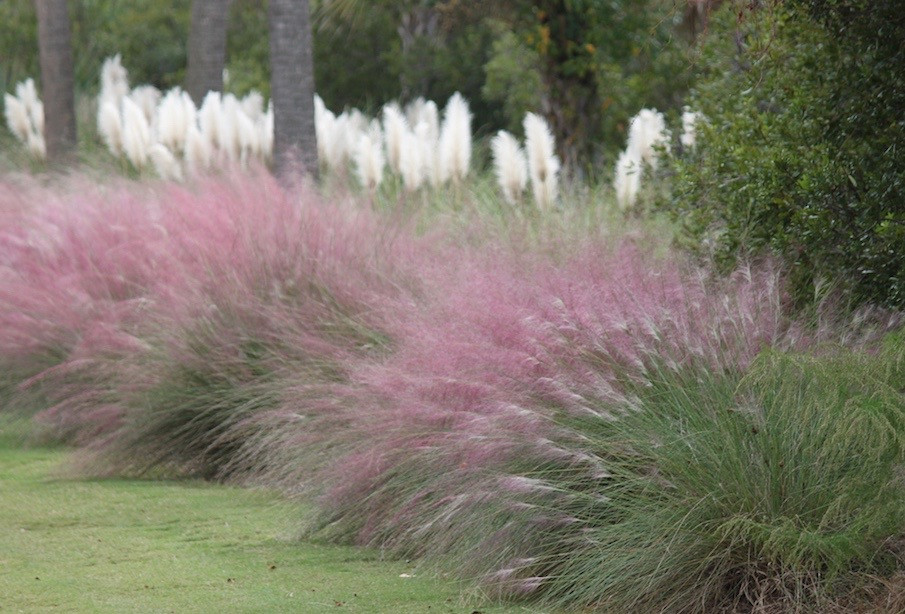
Perennials are the life of any garden, bringing recurring beauty year after year with minimal effort. Unlike annuals, which complete their life cycle in a single season, perennial plants come back every spring, offering long-lasting growth and blooms. Many gardeners are drawn to them because they provide a reliable structure in flower beds, offering seasonal interest without the constant need for replanting.
If you want bees and birds to hover around your garden and pollinate your plants, our well-certified experts will construct and design your garden with native plants that are sure to bring your landscape to life. Our skilled horticulturist and gardeners will plant your garden with stunning native plants that are colorful, offer different shapes and different heights. We have over thirty years of experience, and we pride ourselves on being good stewards of the environment.
Garden that is all Native - Shrubs and Perennials
Perennial Border Created on Long Island Sound


North East Organic Land Care Program to Build Healthy Soils
Peter Atkins and Associates is an accredited NOFA licensed Organic Land Care Business. We will put three factors together to remediate your garden’s soil: nutrient density soil test results, granular amendments, and foliar feeding. A customized program follows the Northeast Organic Farming Association (NOFA)’s Organic Land Care Standards to modify contaminated or compromised soils in order to restore them back to a balanced and healthy growing medium.
Pollinator Gardens acting as Rain Garden to Absorb Run Off in low area near the pool
When To Plant Perennials in the Garden?
Most perennials can and should be planted in the spring, as this allows ample time for root establishment. "A decent rule of thumb is to plant summer-blooming and fall-blooming perennials in spring, shortly after they've awakened and once the danger of freezing soil has passed," says says Adam Dooling, the curator of outdoor garden and herbaceous collections at the New York Botanical Garden.
You should plant spring-blooming and summer-blooming perennials in the fall, allowing enough time for the plants to establish themselves before winter. "Your optimal planting season can either be extended or reduced depending on your climate or conditions that year," says Dooling.
Individual Gardens of Client asking for Perennial Garden Design Services
Natural Looking Perennial Gardens
Many homeowners express a wish for a more spontaneous, natural-looking style of landscaping that is environmentally friendly. Increasing the percentage of perennial plants throughout your landscape is the surest way to accomplish that goal. But many customers have shared that they worry that if they do not choose the right assortment of plants and cultivate them properly the effect will look unkempt. Yes, all perennial gardens including native perennials require some attention to care including deadheading, division and being watered for the first few years until established.
The Natural Look of Perennials - The desire for a more natural-looking garden (think English garden) is a revival of the loose, colorful style that prevailed in the 19th century before a more formal style came along with the invention of the neatly kept modern lawn, and tightly trimmed boxwood hedges and foundation plants that we now see defining home exteriors.
The English Garden offer blends both formal and informal elements. It utilizes mass layering to achieve soft angles and focuses on curvilinear lines to draw your eye throughout the garden. English gardens are known for their unapologetic "abundant" look, where flowers, vegetables and/or shrubs mingle easily like the very best of friends.
This is achieved by "layering" a range of plants with different heights together and is a technique that can be applied from the tiniest garden to the largest estate regardless of aesthetic or level of maintenance that the gardener is willing to do. The English Garden evokes the feeling of romance, and its casual feel can be blend easily with a variety of architectural styles.
It’s best to seek advice from a certified horticulturist such as Peter Atkins CPH, who is familiar with the soil, sun and moisture requirements of the different plant varieties adapted to your region. A horticulturist is a landscape professional who understands how to “stage” and layer plantings to follow bloom cycles. Horticulturists know how and when to prune and fertilize plants so they will mature naturally into the shape they are intended to take.
Wetland Planting on Pond with Perennials

Meadow Planted to replace the lawn in CT
Reducing the amount of lawn and converting this area to functional native plants is a key strategy. Native perennials, trees and shrubs can help you meet this goal of restoring and maintaining biodiversity. In the process, you’ll be sequestering carbon, reducing the need for watering, and attracting pollinators to a self-sustaining community. Native plants lend an authentic sense of place to your home.
More and more gardeners want to attract pollinators. For that we will need to provide nectar, places to roost, and food for the young. Let us suggest a plant palette that will bring in the wildlife AND be sustainable. Native trees, shrubs, perennials and groundcovers can all play a role.
Native Garden located off the rear lawn area within view of this garden
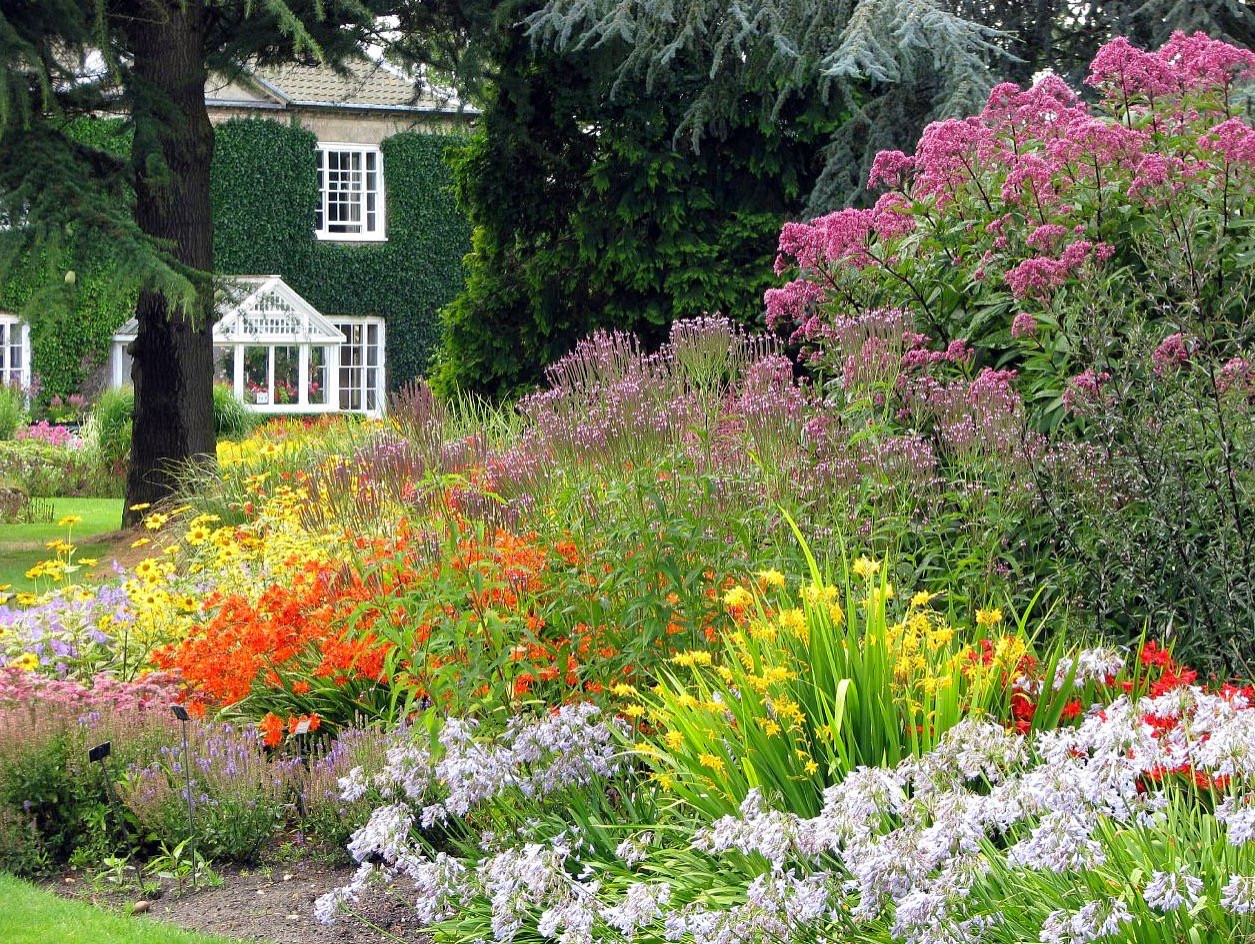
Gardens designed and installed by Peter Atkins and his elite gardeners
TESTIMONIALS
paul harding
“I could not recommend a company more than Peter Atkins and Associates., LLC. They are professional, reliable, timely, honest and perform top quality work consistently. With Peter Atkins, you know you are getting exactly what you ask for each time. We really appreciate your professionalism and calm demeanor throughout the project. We are so excited by this update to our home, which is sure to enhance every gathering we hold with family and friends. In addition to the excellent quality of the work, we would like to thank you for the great communication and reasonable pricing. From our first meeting until the last day of the project, you and Mary Ann provided us with explicit details about the work and were in continuous communication with us about expected progress. We will be more than pleased to recommend you to anyone who needs your horticultural professional help. We are very happy that our entire landscape will be maintained organically, thanks to your guidance and encouragement. Best Regards Paul and IreneRead More
Designing installing and maintaining gardens
Peter takes wonderful care of our landscape. We feel very fortunate to have his advice and services. He has a fantastic eye for designing harmonious planting spaces. He is a meticulous planner and delivers everything that he promises. His exceptional crew brings his visions to life and they take great care of our property. We strongly recommend Peter and his team!Read More
Houzz User
Peter and his team have provided fine garden maintenance on my property for the past two seasons. I reached out to them because, after many attempts at hiring landscapers to maintain my planting beds, the results were always the same. Plants lost to disease, improperly pruned annuals trimmed at the wrong time of year, and the use of chainsaws on all shrubs made me realize I needed a company that was schooled in fine garden design and maintenance. Fortunately, online research led me to Peter's company. After meeting to discuss my goals and hearing his plans, I was thrilled at the possibilities. The transformation was nothing short of magical! The gardens became stunning displays of nature's beauty. Sometimes, that required moving plants around or adding color and dimension to other areas. When it was time for my daughter's wedding event, Peter and his team worked tirelessly to ensure everything was in tip top shape and beautiful. I highly recommend Peter!Read More
John Zimmerman
When I contacted Peter he was enthusiastic about our smallish project to renovate the circle area of our driveway. In the late winter we met and spoke about the goals. After a careful review he gave us a quote which was reasonable and filled all our desires and more for the project. I would reservedly recommend using him for a landscaping project. In fact there are other areas of our property that we may work on with him in the future. (The actual cost was at the very low end of the approximate cost range.)Read More
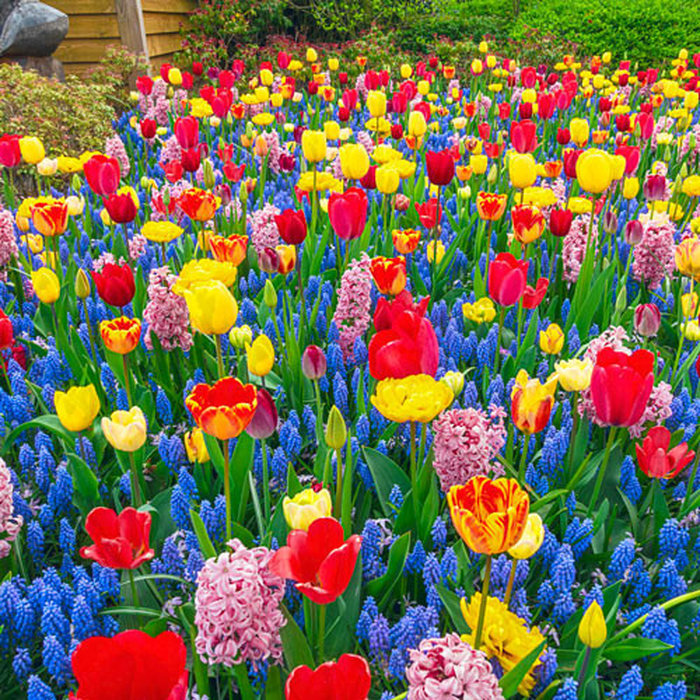
Ready for a Garden Consultation?
Let's talk about your dream yard
Peter Atkins will come to your property, listen to your ideas and talk about how we can work together to create your dream landscape.
Tell us about your landscape goals! Are you interested in stonework, a new planting installation, habitat restoration, or maintenance services for a natural-looking landscape? Or maybe all of the above?
PLEASE SEND ME US AN EMAIL - PeterAtkinsandAssociates@gmail.com
Peter Atkins Cell (914) 234-0161